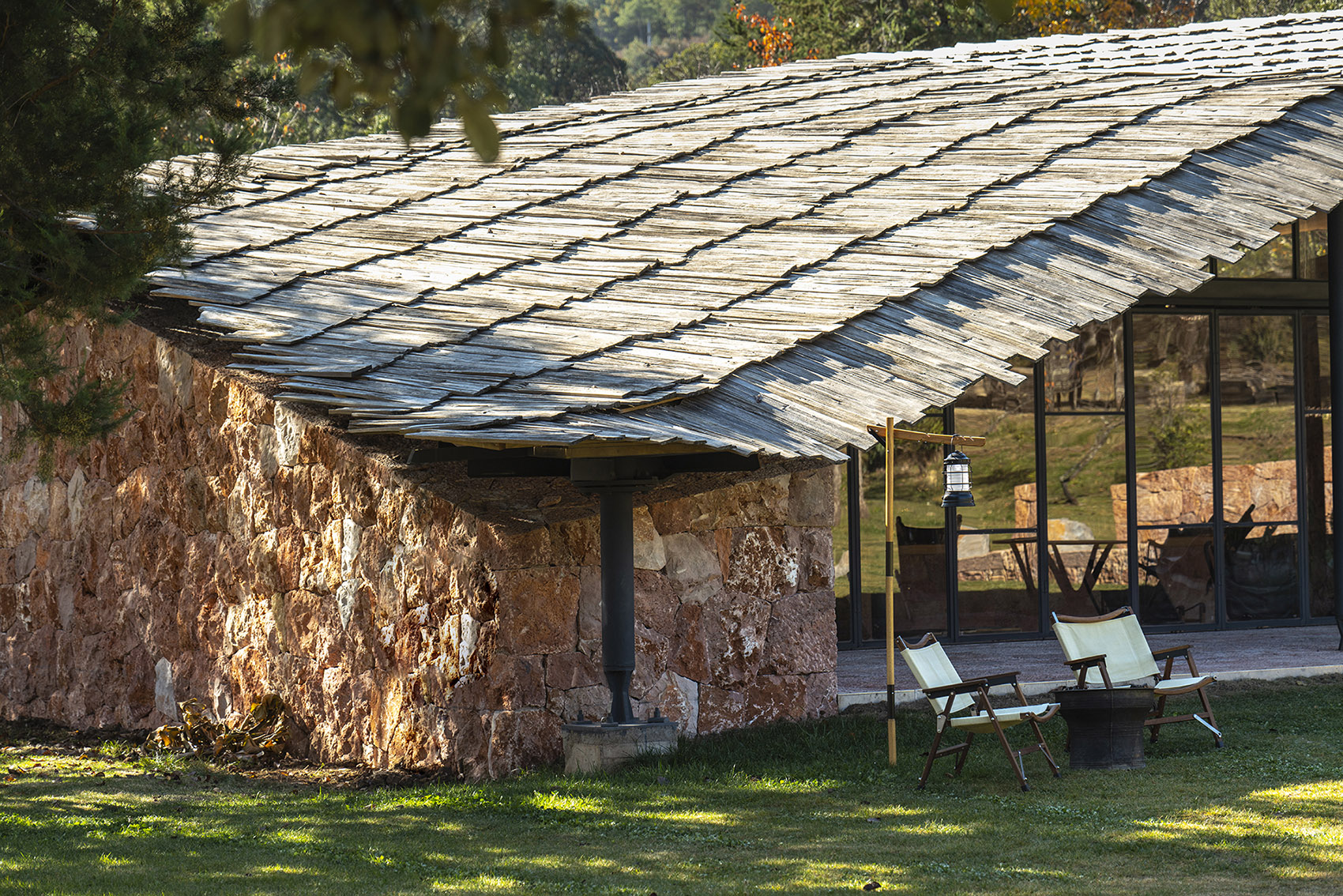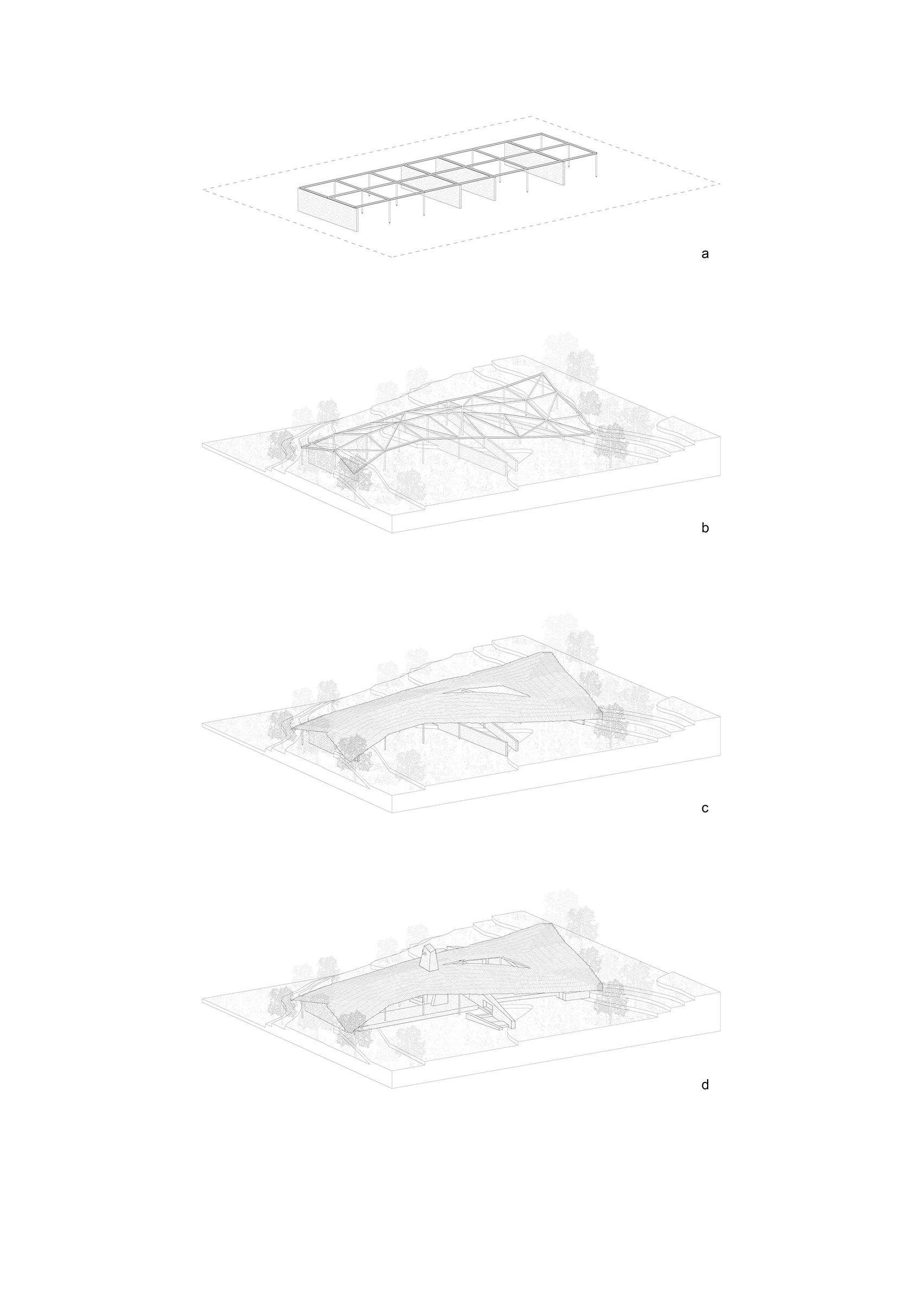对今天的我们来说,时不时的从“原来的世界”适当抽离放松,是一种让内心回归安宁、秩序得以重建的方式,尽管地理概念上的“远方”变得前所未有地容易抵达,但由身而心的度假体验却难得发生。如何才能创造出这种自在松弛的体验?是留给设计师的首要问题。
For us today, taking a break from the “old world” from time to time is a way to restore peace and order. While the geographical concept of “far away” has become more accessible than ever, the vacation experience from the body to the mind rarely happens. How do you create this relaxing experience? “is the priority issue left to the designer.
Hylla落云自然体验中心,同时也是大家口中的“红房子”,位于云南丽江白沙镇岩脚村的缓坡地带,是Hylla Land物与岚·界的一处自然生活场景体验地。一面仰视雪山冰川,一面俯瞰村落田园,除了田园的一侧,其余三面都被芝山延伸下来的完整林冠线亲密包围。项目门前有草坪、水泊和树林,高高低低,依次排开;屋后是一条天然水渠,与酒店主体建筑隔水相望。在这个具体的场地上,建筑师用自己独特的对“当地性”的解读,不拘泥于既有经验和大众标签,让一个“随性”的建筑破土而出。
Hylla Cloud Nature Experience Center, also known as the “Red House”, is located in the gentle slope of Yanjiao Village, Baisha Town, Lijiang, Yunnan Province. It is a natural living scene experience place in Hylla Land. On one side, it looks up at the snow-capped mountains and glaciers, on another side; it overlooks the village and countryside. Except for one side of the countryside, the other three sides are closely surrounded by the complete canopy line extending from the Mount Zhishan. In front of the project, there are lawns, water pools and trees, high and low, successively arranged; behind the house is a natural canal, across the water from the main building of the hotel. In this specific site, the architect uses his own unique interpretation of the “local”, not restricted to the existing experience and the public label, have caused a “casual” building to break through the ground.
▼项目概览,general view © 潘杰

▼鸟瞰,aerial view © 杨光坤

度假是为了寻找松弛时刻,而云南本身就处在理想的松弛状态中。在建筑师的观察里,云南传统建筑建造得都非常自由:老匠人们完全没有特定设计和严格规划,砌着砌着墙可能就突然堆一个石磨进去,边缘和表面也不在乎处理得是否整齐……一切都充满了随机性、想象力和满不在乎的态度。在这样的环境中,建筑师认为对待本项目也应该放松一点。
▼总平面图,site plan © gad

Vacation is to find time of relaxation, and Yunnan itself is in an ideal state of relaxation. From the architect’s observation, Yunnan’s traditional buildings are built with great freedom: the old craftsmen had no specific design or strict planning. They might suddenly pile a stone mill into the wall, and they didn’t care whether the edges and surfaces were properly handled… It’s all about randomness, imagination and carelessness. In this context, the architect felt that the project should also be treated a little more relaxed.
▼屋顶视角,roof top view © 潘杰


丽江的天气总是艳阳高照,云下的阴影总会变成人们的天然遮阳场。而云,天然代表着这种自在的、无拘无束的状态。于是,设计团队轻巧地把一片“云”作为建筑的屋顶,让它自然游走,寻找着自己的边界:遇到场地上散落着的树,就退开些,遇到有空隙的地方,就多延伸进去一点。自然地伸缩舒展,构成俯视视角下的建筑平面形态。
The weather in Lijiang is always sunny, and the shadow under the clouds will always become a natural shading field for people. And the cloud, naturally, represents this relaxed, unfettered state. Instead, the design team used a “cloud” as the roof of the building, allowing it to wander naturally and find its own boundary: when you come across trees scattered on the site, step back a little, and when there is a gap, stretch in more. It naturally expands and stretches, forming the plane form of the building from the overlooking perspective.
▼建筑外观,exterior view © 潘杰

▼檐下空间,the covered space © 潘杰

“云朵”投下的阴影自然就是建筑的空间。受 KaareKlint 1933年设计Safari 户外椅结构原理的启发,建筑师让建筑的支撑结构随着地形的高低起伏而调整,每个边的长度既不固定,也不一致,根据场地条件的变化而变化。整体像是趴伏在草地上的巨大帐篷。这样的结构也与业主对于该建筑的功能定位相呼应。项目场地周围既有平整的草地,又有天然水泊和林地,自然状态下就是露营的好去处。一个“帐篷”形状的营地建筑自带户外感。
▼建筑形体分析图gif,massing diagram gif. © gad

The shadow cast by the “clouds” is naturally the space of the building. Inspired by Kaareklint’s 1933 design for the structure of the outdoor chairs in Safari, the architects allowed the building’s supporting structure to adjust to the ups and down of the terrain. The length of each side is neither fixed nor consistent, and varies according to site conditions. It looks like a huge tent lying on the grass. This structure also responds to the client’s functional orientation of the building. The site is surrounded by a combination of flat grassland, natural water and woodland, making it a great place for camping in its natural state. A tent-shaped camp building comes with an outdoor sense.
▼一片“云”作为建筑的屋顶,a “cloud” as the roof of the building © 潘杰

▼趴伏在草地上的巨大帐篷,a huge tent lying on the grass © Hylla 雷坛坛

除了结构上的自在,落云自然体验中心的建筑在取材上也好似“信手拈来”。地面和墙体连成一体,都用同一种产自丽江本地的石头砌成。建筑内外不做多余的装饰,诚实地裸露出石头本来的颜色和质感。这种石头只产自当地贵峰村,呈现出十分特别的、像火烈鸟一样的粉红色。由于这种石料的大面积使用,整个建筑与颇有野性的云南大环境和野趣十足的所在场地形成色彩上的强烈对比。“红房子”这个随意的名字也由此在工人们的口口相传中得来。
In addition to being structurally comfortable, the architecture materials of the Cloud Nature Experience Center also seem to be “handy”. The floor and walls are integrated, all made of the same kind of local stone from Lijiang. There is no redundant decoration for the interior and exterior of the building and it has honestly exposed the original color and texture of the stone. The stones, produced only in the local village of Guifeng, have a very distinctive flamingo-like pink color. Due to the extensive use of this stone material, the whole building forms a strong color contrast with the wild Yunnan environment and the rustic charm of the site. The casual name “Red House” has been thus derived from word of mouth among the workers.
▼地面和墙体连成一体,都用同一种产自丽江本地的石头砌成 © 潘杰 The floor and walls are integrated, all made of the same kind of local stone from Lijiang


设计团队在看场地的时候发现地上堆了很多拆下来的旧木头,就直接回收了它们,错落拼接成屋顶。拼装边缘也并不刻意对齐,长短不一地保留着手工痕迹,也是对云南“满不在乎”的生存哲学的又一次回应。
When the design team visited the site, they noticed that there were a lot of old pieces of wood on the ground, so they directly recycled them and spliced them into a roof. The edges are not deliberately aligned, and the manual traces are kept in different lengths, which is another response to the “careless” survival philosophy of Yunnan.
▼回收的旧木头错落拼接成屋顶,recycled pieces of wood were spliced into a roof © 潘杰



不过取材的“随意”并不意味着建造过程的简单。在机器作业高度发达的今天,为了保持石材的天然质感,建筑所使用的每一块石材都是由石匠刀劈手凿来完成。
However, taking materials “casually” doesn’t mean the construction process is easy. In today’s highly developed machine operation, in order to maintain the natural texture of the stone, each stone used in the building was chiseled by a mason with a tool.
▼建筑细节,detailed view © 潘杰



对建筑师来说,这个建筑的建造就如同烹饪分子料理:用当地的材料,制作出一个并不当地的东西。最终,建筑师用简单的材料,通过并不复杂的手法,让它成了一个符合当地精神、与自然交互、有设计感、也有温度的现代建筑。
For the architects, the construction of this building is like cooking molecular cuisine: take local materials and make something that is not local. In the end, the architect has used simple materials and uncomplicated methods to make it a modern building that conforms to the local spirit, interacts with nature, and has a sense of design and feeling.
▼走廊和阶梯细节,corridor and stair details © 潘杰




除了在外形上的不拘一格,另外一个区别于传统建筑的是,“红房子”并没有事先预设使用规则。在建筑师看来,建筑不应该高傲地决定使用者在建筑里如何行动,“如何体验”是一个开放的文本,建筑师只提供可能性。
In addition to being eclectic in appearance, another difference between the “red house” and traditional buildings is that there are no preset rules for its use. From the architect’s point of view, the building should not be proud to decide what the user should do in the building. “How to Experience” is an open text and the architect offers only possibilities.
▼开放性的体验,an open experience © 潘杰

首先,建筑与自然的边界被模糊,使用者可以随意选择自己接触和感受自然的方式。不过,建筑师认为“当地性”需要被尊重,体验者的“异乡人”身份也应当得到正视。对异乡人而言,看雪山就是一项极重要的获得差异感的体验。
First of all, the boundary between the building and nature is blurred, and users can freely choose the way they touch and feel nature. However, the architects believe that “locality” needs to be respected and the “stranger” identity of the experiencers should also be respected. For strangers, seeing snow-capped mountains is an important experience to gain a sense of difference.
▼从户外休息区望向雪山 © 潘杰 view to the snow-capped mountains from the outdoor seating area

“红房子”在设计时就考虑了如何让人更好地“看山”。对于整个度假体验来说,传播旅行中的乐趣也是构成完整旅行体验的重要部分。因此“如何能更好地拍山?”也很重要。一个独特的看山之所,少不了独特的“花式”看山角度和多种自由的看山姿态。
The Red House was designed with a better view of the mountains in mind. Spreading the fun of the trip is also an important part of the overall vacation experience. So “how can I photograph the mountains better?” is also very important. A unique place to see the mountains is indispensable from the unique “fancy” view angles of the mountain and a variety of free mountain viewing poses.
▼多种自由的看山姿态, a variety of free mountain viewing poses © 潘杰



在内部功能区分上,落云自然体验中心除了做出休息活动区、洗浴区、储藏室这样必要的分隔,没有做出更多的空间限制。休息区是一个开放性的场所,到底是咖啡馆、酒吧、零售中心,还是会场?如何使用,完全随需求变化。而空间的体验者也可以自主选择自己觉得舒服的方式呆着。椅子、台阶、屋顶,或坐或躺,或站或走,随心所欲,不加拘束,充分尊重使用者的主体性。
▼平面图,plan © gad

In terms of internal function differentiation, Cloud Nature Experience Center has not made more space restrictions in addition to the necessary separation of rest and activity area, bath area and storage room. The lounge area is an open space, is it a cafe, a bar, a retail center, or a sharing venue? How will you use it, it all depends on your needs. And the experiencer of the space can also choose to stay in the way they feel comfortable. With chairs, steps and roofs, you may sit or lie, or stand or idle about, follow your inclinations and respect the user’s subjectivity adequately.
▼户外休息区,outdoor seating area © 潘杰


▼室内休息活动区,lounge area © 潘杰


▼开放的场所包含多种功能,an open space aimed for different functions © 潘杰


为了满足奢野露营需要的洗浴空间则由半透明玻璃砖构筑,外面可以看到卫生间里模模糊糊的人影,有点像飞机穿过云层时若隐若现的感受。而浴室的环境和淋雨系统则会模拟自然界中暴雨如注的效果。毫无疑问,这是一场充满不确定性的体验,设计者在“放肆”的边缘跃跃欲试。
The bathing space for camping is made of translucent glass tiles. Outside, you can see the blurry shapes of people in the bathroom, a bit like an airplane passing through a cloud. The bathroom environment and the shower system will simulate the effects of rainstorms in nature. There is no doubt that this is an experience full of uncertainty, and the designer is on the “unbridled” verge.
▼洗浴空间则半透明玻璃砖构筑,the bathing space for camping is made of translucent glass tiles © 潘杰


▼玻璃砖墙细节,glass brick wall details © 潘杰


纵观整个设计和建造的过程,建筑师并没有僵化地去寻找和模仿云南当地建筑形式上的相似性,相反,他做了一个看起来完全不像当地建筑的建筑,但直指当地建筑风格的内在精神——自然自在、随心松弛。
Throughout the design and construction process, the architects did not rigidly seek and imitate the similarity of Yunnan’s local architectural forms. Instead, he made a building that looks nothing like the local architecture, but speaks directly to the inner spirit of the local architecture-natural and comfortable and relax as you please.
Returning to the question of “how can we create a relaxing experience for visitors”, the builders themselves relax first and wonder if it is also a path.
▼Hylla落云自然体验中心,Hylla Cloud Nature Experience Center © 潘杰

▼立面图,elevations © gad




项目名称:Hylla落云自然体验中心 项目地点:云南,丽江 详细地址:云南省丽江市玉龙县白沙镇岩脚村99号 项目类型:酒店/营地中心 设计时间:2019年8月 建成时间:2020年6月 项目规模:538 ㎡ 设计单位:gad 项目主创:程越 完整团队成员:汤珺如 施懿媛 马佳 吕超豪 赵雨婷 马宇晴 建筑和室内硬装设计:程越 汤珺如 施懿媛 马佳 吕超豪 赵雨婷 马宇晴 结构设计:李保忠 黄杰 给排水设计:程永清 暖通设计:房园园 电气设计:潘小艳 现场营造团队:杨飞 黄清祥 胡秋锦 王佳蕾 饶飞 王侯 施工团队:戴金贵 廖海宾 韩傅俊 刘欢等 业主:HYLLA 物与岚 摄影师:潘杰 Hylla雷坛坛 杨光坤 程越 吴瑕 孙一文 杨飞 结构手法:砌体和钢结构 建筑材料:石材 回收木板 钢 玻璃砖
Project Name: Hylla Cloud Nature Experience Center Location: Lijiang, Yunnan Province Address: No. 99, Yanjiao Village, Baisha Town, Yulong County, Lijiang City, Yunnan Province Project Type: Hotel/Camp center Date of Design: August 2019 Date of Completion: June 2020 Project Scale: 538 ㎡ Design unit: gad Project Creator: Yue Cheng Team Members: Junru Tang, Yiyuan Shi, Jia Ma, Chaohao Lv, Yuting Zhao, Yuqing Ma Architecture and Interior Decoration Design: Yue Cheng, Junru Tang, Yiyuan Shi, Jia Ma, Chaohao Lv, Yuting Zhao, Yuqing Ma Structure design: Baozhong Li and Jie Huang Water Supply and Drainage Design: Yongqing Cheng HVAC Design: Yuanyuan Fang Electrical Design: Xiaoyan Pan Site Construction Team: Fei Yang, Qingxiang Huang, Qiujin Hu, Jialei Wang, Fei Rao, Hou Wang Construction Team: Jingui Dai, Haibin Liao, Fujun Han, Huan Liu, etc. Owner: HYLLA Land Photographers: Jie Pan, Tantan Lei, Guangkun Yang, Yue Cheng, Xia Wu, Yiwen Sun, Fei Yang Structure Technique: Masonry and Steel Structure Building Materials: Stone, Recycled Wood, Steel, Glass Brick






























































































































































